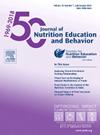Emerging Adults Report Internal, External, and Social/Environmental Motivations for Weight-Related Self-Monitoring Application Use
IF 2.3
3区 医学
Q2 EDUCATION, SCIENTIFIC DISCIPLINES
引用次数: 0
Abstract
Objective
To describe the factors that motivate emerging adults to engage in weight-related self-monitoring (WRSM) and to determine the age of initiating WRSM.
Design
Mixed-methods cross-sectional study, including quantitative survey and semi-structured interviews.
Participants
Tracking-EAT participants came from the population-based sample of Project EAT (Eating and Activity over Time); 138 participants (mean age=26.5 years; range 22–29) completed a survey, 25 of which also completed a semi-structured interview.
Main Outcome Measure
Internal and external motivations for WRSM and the age when participants began WRSM were assessed quantitatively. Semi-structured interviews assessed how participants were introduced to and why they used WRSM.
Analysis
Descriptive statistics for quantitative measures. Inductive thematic analysis for qualitative analyses.
Results
Participants reported internal (e.g., trying to lose weight, change body shape), external (e.g., advice from health professionals, friends/or family), and social/environmental motivations (e.g., WRSM being ubiquitous in our culture). A sense of moral obligation to strive for health contributed to participants’ motivation to engage in WRSM. Participants reported self-monitoring dietary intake and weight as young as 8 years old and exercise as young as 9 years old.
Conclusions and Implications
Numerous factors converge to normalize and encourage WRSM, including internal, external, and social/environmental motivations. Future research could explore how the age of introduction and motivation for use affect the health impacts of WRSM.
新兴成年人报告使用与体重有关的自我监测应用程序的内部、外部和社会/环境动机。
目的:探讨初出期成人参与体重相关自我监测(WRSM)的因素,并确定开始体重相关自我监测的年龄。设计:混合方法横断面研究,包括定量调查和半结构化访谈。参与者:跟踪饮食的参与者来自以人群为基础的EAT项目样本(长期饮食和活动);138名参与者(平均年龄26.5岁;范围22-29)完成了一项调查,其中25人还完成了半结构化访谈。主要结果测量:定量评估WRSM的内部和外部动机以及参与者开始WRSM的年龄。半结构化访谈评估了参与者是如何被介绍给WRSM的,以及他们为什么使用WRSM。分析:用于定量测量的描述性统计。归纳主题分析为定性分析。结果:参与者报告了内部动机(例如,试图减肥,改变体型),外部动机(例如,来自健康专业人员,朋友/或家人的建议)和社会/环境动机(例如,WRSM在我们的文化中无处不在)。争取健康的道德义务感促进了参与者参与水资源管理的动机。参与者早在8岁就开始自我监测饮食摄入和体重,早在9岁就开始锻炼。结论和启示:许多因素汇聚在一起,使水资源管理正常化并鼓励水资源管理,包括内部、外部和社会/环境动机。未来的研究可以探讨引入年龄和使用动机如何影响水sm对健康的影响。
本文章由计算机程序翻译,如有差异,请以英文原文为准。
求助全文
约1分钟内获得全文
求助全文
来源期刊
CiteScore
4.20
自引率
11.50%
发文量
379
审稿时长
44 days
期刊介绍:
The Journal of Nutrition Education and Behavior (JNEB), the official journal of the Society for Nutrition Education and Behavior, is a refereed, scientific periodical that serves as a global resource for all professionals with an interest in nutrition education; nutrition and physical activity behavior theories and intervention outcomes; complementary and alternative medicine related to nutrition behaviors; food environment; food, nutrition, and physical activity communication strategies including technology; nutrition-related economics; food safety education; and scholarship of learning related to these areas.
The purpose of JNEB is to document and disseminate original research and emerging issues and practices relevant to these areas worldwide. The Journal of Nutrition Education and Behavior welcomes evidence-based manuscripts that provide new insights and useful findings related to nutrition education research, practice and policy. The content areas of JNEB reflect the diverse interests in nutrition and physical activity related to public health, nutritional sciences, education, behavioral economics, family and consumer sciences, and eHealth, including the interests of community-based nutrition-practitioners. As the Society''s official journal, JNEB also includes policy statements, issue perspectives, position papers, and member communications.

 求助内容:
求助内容: 应助结果提醒方式:
应助结果提醒方式:


